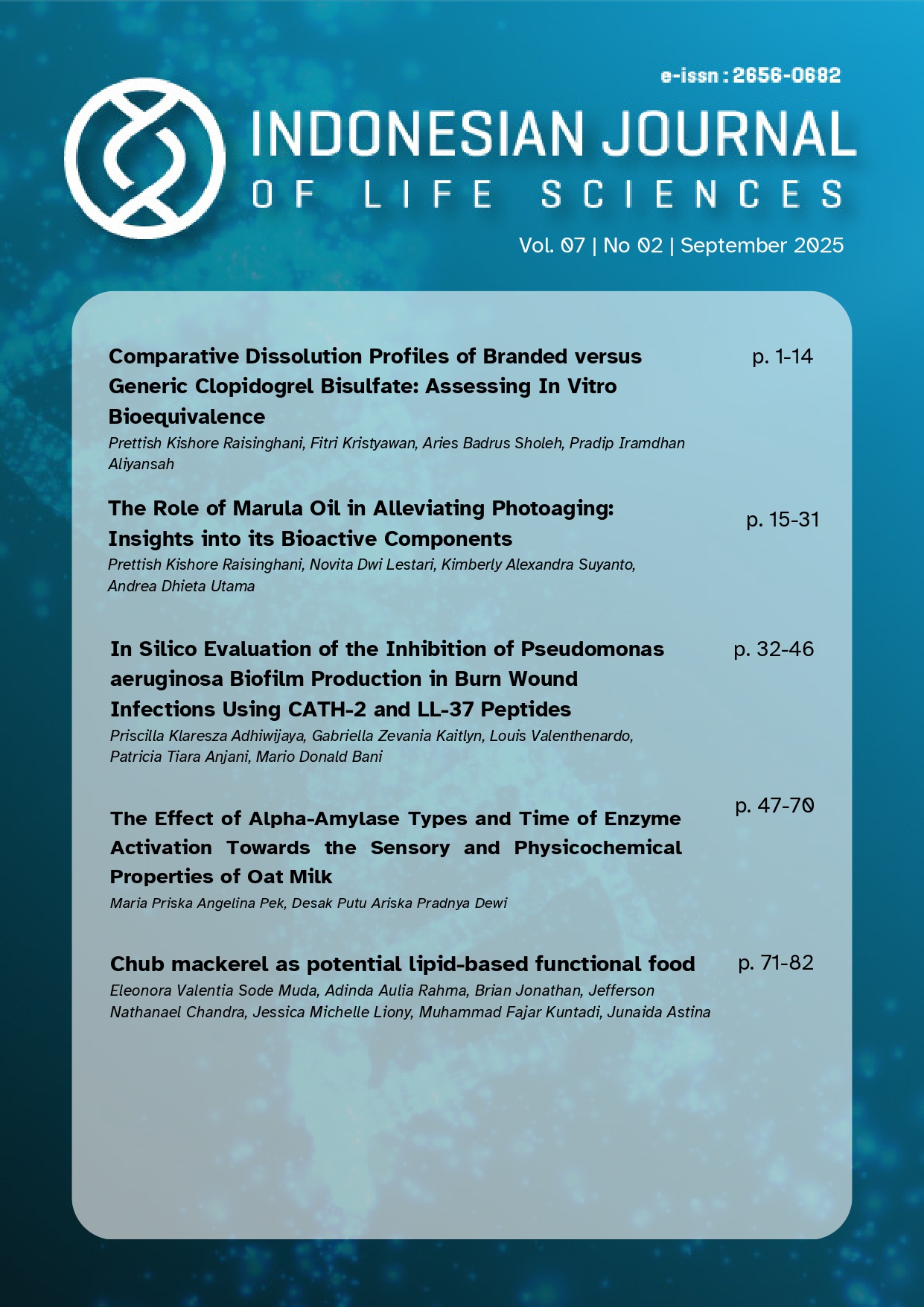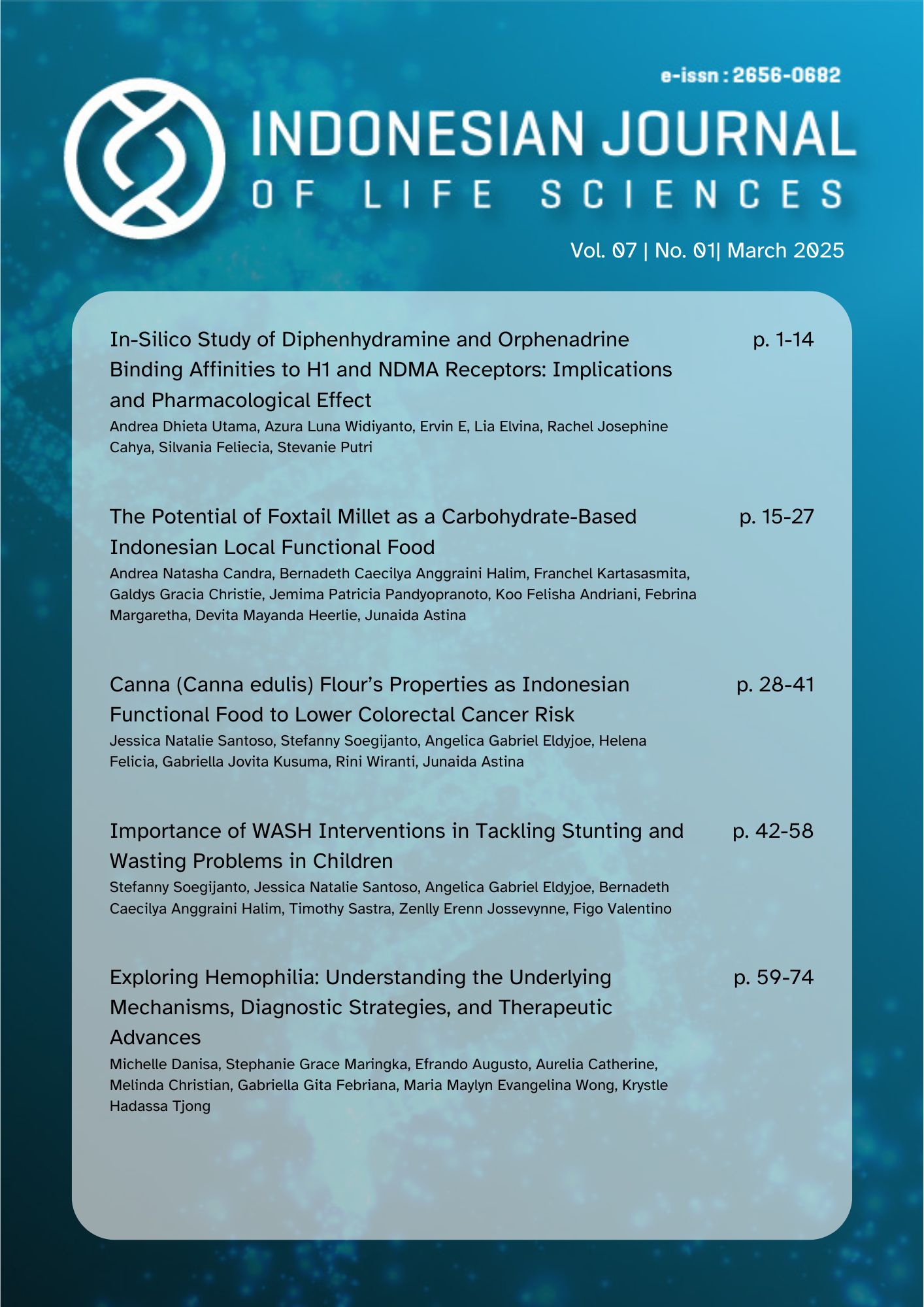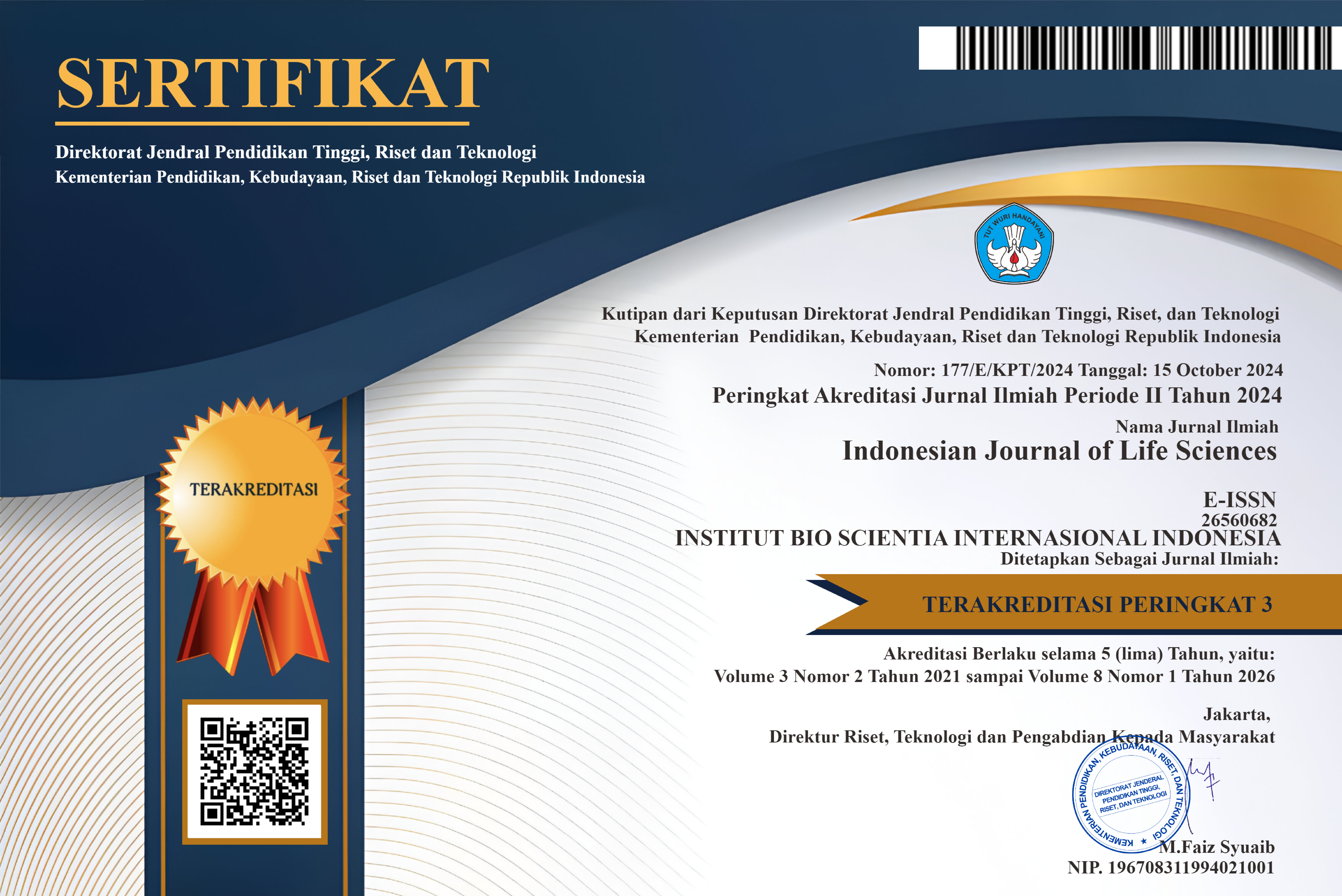In Silico Evaluation of the Inhibition of Pseudomonas aeruginosa Biofilm Production in Burn Wound Infections Using CATH-2 and LL-37 Peptides
Abstract
Patients with burn injuries are at high risk of bacterial infection due to the loss of the skin barrier, often leading to complications that contribute to increasing death tolls from burn injuries. The formation of biofilms in bacteria increases its survival rate, especially in the rise of antibiotic resistance cases, which ineffectively combats biofilm production. This research explores the use of two types of cationic antimicrobial peptides, LL-37 and CATH2, commonly originating from humans and chickens, respectively, as a form of host defense in preventing the formation of biofilms by one of the most common pathogenic bacterial strains in severe burn wounds, Pseudomonas aeruginosa, through inhibition in its LPS region. In silico analyses were performed using AlphaFold, GLYCAM-Web, YASARA, and AutoDock Vina. It was found that the CATH-2 model has the strongest binding affinity towards the three types of LPS—alginate, Pel, and Psl—scoring between -5.5 and -6.0 kcal/mol, as opposed to the score range of -4.1 to -6.0 for LL-37. However, the LL-37 model is considered more precise than the CATH-2 model overall, meaning the in silico results of the former are likely more accurate in real life than the latter. These results suggest the utilization of the two peptides as treatments in severe burn cases. In future developments, the application of genetically engineered plasmid-inserted Staphylococcus epidermidis, a commensal bacterium commonly found on human skin, to produce peptides may be considered.
Downloads
References
Angkoso, H., & Kekalih, A. (2022). Prognostic factors for mortality of pediatric burn injury in a national tertiary referral center. UI Scholars Hub. https://scholarhub.ui.ac.id/nrjs/vol7/iss2/3/
Bondos, S. E., Dunker, A. K., & Uversky, V. N. (2022). Intrinsically disordered proteins play diverse roles in cell signaling. Cell Communication and Signaling, 20(1), 20. https://doi.org/10.1186/s12964-022-00821-7
Burgess, M., Valdera, F., Varon, D., Kankuri, E., & Nuutila, K. (2022). The immune and regenerative response to burn injury. Cells, 11(19), 3073. https://doi.org/10.3390/cells11193073
Cabral, M. B., Dela-Cruz, C. J., Sato, Y., Oyong, G., Rempillo, O., Galvez, M. C., & Vallar, E. (2022). In silico approach in the evaluation of pro-inflammatory potential of polycyclic aromatic hydrocarbons and volatile organic compounds through binding affinity to the human toll-like receptor 4. International Journal of Environmental Research and Public Health, 19(14), 8360. https://doi.org/10.3390/ijerph19148360
Chen, H., Wubbolts, R. W., Haagsman, H. P., & Veldhuizen, E. J. A. (2018). Inhibition and eradication of Pseudomonas aeruginosa biofilms by host defence peptides. Scientific Reports, 8(1). https://doi.org/10.1038/s41598-018-28842-8
Chung, J., Eisha, S., Park, S., Morris, A. J., & Martin, I. (2023). How three self-secreted biofilm exopolysaccharides of pseudomonas aeruginosa, psl, pel, and alginate, can each be exploited for antibiotic adjuvant effects in cystic fibrosis lung infection. International Journal of Molecular Sciences, 24(10), 8709. https://doi.org/10.3390/ijms24108709
Corbo, T., Kalajdzic, A., Delic, D., Suleiman, S., & Pojskic, N. (2022). In silico prediction suggests inhibitory effect of halogenated boroxine on human catalase and carbonic anhydrase. Journal of Genetic Engineering and Biotechnology, 20(1), 153. https://doi.org/10.1186/s43141-022-00437-x
Dewani, N. T., Budi, A. S., & Koendhori, E. B. (2024). Antibiotic resistance in bacteria on burn wound patients: A review of current literature. International Journal of Scientific Advances, 5(6). https://doi.org/10.51542/ijscia.v5i6.49
Farhana, A., & Khan, Y. S. (2023). Biochemistry, lipopolysaccharide. In StatPearls [Internet]. StatPearls Publishing. https://www.ncbi.nlm.nih.gov/books/NBK554414/
Ghosh, A., Jayaraman, N., & Chatterji, D. (2020). Small-molecule inhibition of bacterial biofilm. ACS omega, 5(7), 3108-3115. https://pubs.acs.org/doi/full/10.1021/acsomega.9b03695
Gonzalez, M. R., Fleuchot, B., Lauciello, L., Jafari, P., Applegate, L. A., Raffoul, W., Que, Y. A., & Perron, K. (2016). Effect of human burn wound exudate on Pseudomonas aeruginosa virulence. mSphere, 1(2), e00111–15. https://doi.org/10.1128/mSphere.00111-15
Greenhalgh, D. G. (2019). Management of burns. The New England Journal of Medicine, 380(24), 2349–2359. https://doi.org/10.1056/NEJMra1807442
Gyawali, B., Ramakrishna, K., & Dhamoon, A. S. (2019). Sepsis: The evolution in definition, pathophysiology, and management. SAGE Open Medicine, 7, 2050312119835043. https://doi.org/10.1177/2050312119835043
Hateet, R. (2021). Isolation and identification of some bacteria contemn in burn wounds in Misan, Iraq. Archives of Razi Institute, 76(6), 1665. https://doi.org/10.22092/ari.2021.356367.1833
Hughes, G., & Webber, M. A. (2017). Novel approaches to the treatment of bacterial biofilm infections. British Journal of Pharmacology, 174(14), 2237–2246. https://doi.org/10.1111/bph.13706
Huszczynski, S. M., Lam, J. S., & Khursigara, C. M. (2019). The Role of Pseudomonas aeruginosa Lipopolysaccharide in Bacterial Pathogenesis and Physiology. Pathogens, 9(1), 6. https://doi.org/10.3390/pathogens9010006
Jeschke, M. G., van Baar, M. E., Choudhry, M. A., Chung, K. K., Gibran, N. S., & Logsetty, S. (2020). Burn injury. Nature Reviews Disease Primers, 6(1), 11. https://doi.org/10.1038/s41572-020-0145-5
Khurshid, Z., Naseem, M., Asiri, F. Y. I., Mali, M., Khan, R. S., Sahibzada, H. A., Zafar, M. S., Moin, S. F., & Khan, E. (2017). Significance and Diagnostic Role of Antimicrobial Cathelicidins (LL-37) Peptides in Oral Health. Biomolecules, 7(4), 80–80. https://doi.org/10.3390/biom7040080
Kulandaisamy, A., Lathi, V., ViswaPoorani, K., Yugandhar, K., & Gromiha, M. M. (2017). Important amino acid residues involved in folding and binding of protein–protein complexes. International Journal of Biological Macromolecules, 94, 438-444. https://doi.org/10.1016/j.ijbiomac.2016.10.045
Kulkarni, N. N., O'Neill, A. M., Dokoshi, T., Luo, E. W. C., Wong, G. C. L., & Gallo, R. L. (2021). Sequence determinants in the cathelicidin LL-37 that promote inflammation via presentation of RNA to scavenger receptors. The Journal of Biological Chemistry, 297(1), 100828. https://doi.org/10.1016/j.jbc.2021.100828
Lee, E., & Anjum, F. (2023, April 27). Staphylococcus epidermidis Infection. Nih.gov; StatPearls Publishing. https://www.ncbi.nlm.nih.gov/books/NBK563240/
Lu, J., Yang, M., Zhan, M., Xu, X., Yue, J., & Xu, T. (2017). Antibiotics for treating infected burn wounds. The Cochrane Database of Systematic Reviews, 2017(7), CD012084. https://doi.org/10.1002/14651858.CD012084.pub2
Melamed, J., & Brockhausen, I. (2021). Biosynthesis of bacterial polysaccharides. Comprehensive Glycoscience, 3, 143–178. https://doi.org/10.1016/B978-0-12-819475-1.00097-3
Memariani H., & Memariani, M. (2023). Antibiofilm properties of cathelicidin LL-37: An in-depth review. World Journal of Microbiology & Biotechnology Incorporating the MIRCEN Journal of Applied Microbiology and Biotechnology/World Journal of Microbiology & Biotechnology, 39(4). https://doi.org/10.1007/s11274-023-03545-z
Norbury, W., Herndon, D. N., Tanksley, J., Jeschke, M. G., Finnerty, C. C., & Scientific Study Committee of the Surgical Infection Society. (2016). Infection in burns. Surgical infections, 17(2), 250–255. https://doi.org/10.1089/sur.2013.134
Ordonez, S. R., Amarullah, I. H., Wubbolts, R. W., Veldhuizen, E. J., & Haagsman, H. P. (2014). Fungicidal mechanisms of cathelicidins LL-37 and CATH-2 revealed by live-cell imaging. Antimicrobial agents and chemotherapy, 58(4), 2240–2248. https://doi.org/10.1128/AAC.01670-13
Pangli, H., & Papp, A. (2019). The relation between positive screening results and MRSA infections in burn patients. Burns, 45(7), 1585-1592. https://doi.org/10.1016/j.burns.2019.02.023
Preda, V. G., & Săndulescu, O. (2019). Communication is the key: Biofilms, quorum sensing, formation and prevention. Discoveries, 7(3), e100. https://doi.org/10.15190/d.2019.13
Radzikowska-Büchner, E., Łopuszyńska, I., Flieger, W., Tobiasz, M., Maciejewski, R., & Flieger, J. (2023). An overview of recent developments in the management of burn injuries. International Journal of Molecular Sciences, 24(22), 16357. https://doi.org/10.3390/ijms242216357
Ramírez, D., & Caballero, J. (2018). Is it reliable to take the molecular docking top scoring position as the best solution without considering available structural data? Molecules, 23(5), 1038. https://doi.org/10.3390/molecules23051038
Reynolds, D., & Kollef, M. (2021). The epidemiology and pathogenesis and treatment of Pseudomonas aeruginosa infections: An update. Drugs, 81(18), 2117–2131. https://doi.org/10.1007/s40265-021-01635-6
Ruff, K. M., & Pappu, R. V. (2021). AlphaFold and implications for intrinsically disordered proteins. Journal of Molecular Biology, 433(20), 167208. http://dx.doi.org/10.1016/j.jmb.2021.167208
Sargsyan, K., Grauffel, C., & Lim, C. (2017). How Molecular Size Impacts RMSD Applications in Molecular Dynamics Simulations. Journal of Chemical Theory and Computation, 13(4), 1518–1524. https://doi.org/10.1021/acs.jctc.7b00028
Scheenstra, M. R., van den Belt, M., Tjeerdsma-van Bokhoven, J. L. M., Schneider, V. A. F., Ordonez, S. R., van Dijk, A., Veldhuizen, E. J. A., & Haagsman, H. P. (2019). Cathelicidins PMAP-36, LL-37 and CATH-2 are similar peptides with different modes of action. Scientific Reports, 9(1), 4780. https://doi.org/10.1038/s41598-019-41246-6
Scheenstra, M. R., van Harten, R. M., Veldhuizen, E. J. A., Haagsman, H. P., & Coorens, M. (2020). Cathelicidins Modulate TLR-Activation and Inflammation. Frontiers in Immunology, 11, 1137. https://doi.org/10.3389/fimmu.2020.01137
Schneider, V., Coorens, M., Ordonez, S. et al. Imaging the antimicrobial mechanism(s) of cathelicidin-2. Scientific Reports, 6, 32948 (2016). https://doi.org/10.1038/srep32948
Singer, A. J., & Boyce, S. T. (2017). Burn wound healing and tissue engineering. Journal of Burn Care & Research : Official Publication of the American Burn Association, 38(3), e605. https://doi.org/10.1097/BCR.0000000000000538
Sivakumar, K. C., Haixiao, J., Naman, C. B., & Sajeevan, T. P. (2020). Prospects of multitarget drug designing strategies by linking molecular docking and molecular dynamics to explore the protein–ligand recognition process. Drug Development Research, 81(6), 685–699. https://doi.org/10.1002/ddr.21673
Soedjana, H., Nadia, J., Sundoro, A., Hasibuan, L., Rubianti, I. W., Putri, A. C., & Harianti, S. (2020). The profile of severe burn injury patients with sepsis in Hasan Sadikin Bandung General Hospital. Annals of Burns and Fire Disasters, 33(4), 312. https://www.ncbi.nlm.nih.gov/pmc/articles/PMC7894849/
Tasleem, S., Siddiqui, A. I., Zuberi, M. A. W., Tariq, H., Abdullah, M., Hameed, A., Aijaz, A., Shah, H. H., Hussain, M. S., & Oduoye, M. O. (2024). Mortality patterns and risk factors in burn patients: A cross-sectional study from Pakistan. Burns Open, 8(1), 13–18. https://doi.org/10.1016/j.burnso.2023.11.003
Thakur, B., Arora, K., Gupta, A., & Guptasarma, P. (2020). Mechanism of bacterial adhesion and embedment in a DNA biofilm matrix: Evidence that binding of outer membrane lipopolysaccharide (LPS) to HU is key. bioRxiv. https://doi.org/10.1101/2020.10.20.346890
Van Harten, R. M., Van Woudenbergh, E., Van Dijk, A., & Haagsman, H. P. (2018). Cathelicidins: immunomodulatory antimicrobials. Vaccines, 6(3), 63. https://doi.org/10.3390/vaccines6030063
Varadi, M., Anyango, S., Deshpande, M., Nair, S., Natassia, C., Yordanova, G., Yuan, D., Stroe, O., Wood, G., Laydon, A., Žídek, A., Green, T., Tunyasuvunakool, K., Petersen, S., Jumper, J., Clancy, E., Green, R., Vora, A., Lutfi, M., ... Velankar, S. (2022). AlphaFold protein structure database: Massively expanding the structural coverage of protein-sequence space with high-accuracy models. Nucleic Acids Research, 50(D1), D439–D444. https://doi.org/10.1093/nar/gkab1061
Varela, M. F., Stephen, J., Lekshmi, M., Ojha, M., Wenzel, N., Sanford, L. M., Hernandez, A. J., Parvathi, A., & Kumar, S. H. (2021). Bacterial resistance to antimicrobial agents. Antibiotics, 10(5), 593. https://doi.org/10.3390/antibiotics10050593
Wardhana, A., Basuki, A., Prameswara, A. D. H., Rizkita, D. N., Andarie, A. A., & Canintika, A. F. (2017). The epidemiology of burns in Indonesia’s national referral burn center from 2013 to 2015. Burns Open, 1(2), 67–73. https://doi.org/10.1016/j.burnso.2017.08.002
World Health Organization. (2022). Global antimicrobial resistance and use surveillance system (GLASS) report: 2022. https://www.who.int/publications/i/item/9789240062702
World Health Organization. (2023). Burns. https://www.who.int/news-room/fact-sheets/detail/burns
Xiao, Q., Luo, Y., Shi, W., Lu, Y., Xiong, R., Wu, X., Huang, H., Zhao, C., Zeng, J., & Chen, C. (2022). The effects of LL-37 on virulence factors related to the quorum sensing system of Pseudomonas aeruginosa. Annals of Translational Medicine, 10(6). https://doi.org/10.21037/atm-22-617
Yacoub, H. A., Elazzazy, A. M., Mahmoud, M. M., Baeshen, M. N., Al-Maghrabi, O. A., Alkarim, S., Ahmed, E. S., Almehdar, H. A., & Uversky, V. N. (2016). Chicken cathelicidins as potent intrinsically disordered biocides with antimicrobial activity against infectious pathogens. Developmental & Comparative Immunology, 65, 8–24. https://doi.org/10.1016/j.dci.2016.06.012
Yasir, M., Willcox, M., & Dutta, D. (2018). Action of Antimicrobial Peptides against Bacterial Biofilms. Materials, 11(12), 2468. doi:10.3390/ma11122468
Żwierełło, W., Piorun, K., Skórka-Majewicz, M., Maruszewska, A., Antoniewski, J., & Gutowska, I. (2023). Burns: Classification, pathophysiology, and treatment: A review. International Journal of Molecular Sciences, 24(4), 3749. https://doi.org/10.3390/ijms24043749

This work is licensed under a Creative Commons Attribution 4.0 International License.
Articles published in Indonesian Journal Life of Sciences are licensed under a Creative Commons Attribution-ShareAlike 4.0 International license. You are free to copy, transform, or redistribute articles for any lawful purpose in any medium, provided you give appropriate credit to the original author(s) and Indonesian Journal Life of Sciences, link to the license, indicate if changes were made, and redistribute any derivative work under the same license. Copyright on articles is retained by the respective author(s), without restrictions. A non-exclusive license is granted to Indonesian Journal Life of Sciences to publish the article and identify itself as its original publisher, along with the commercial right to include the article in a hardcopy issue for sale to libraries and individuals. By publishing in Indonesian Journal Life of Sciences, authors grant any third party the right to use their article to the extent provided by the Creative Commons Attribution-ShareAlike 4.0 International license.











